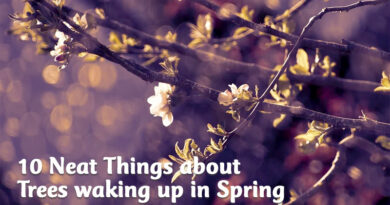6 Must-Have Perennials
Sun or shade, to short and squatty or sassy show-stoppers here are our top six picks for your must-have perennials in your gardens.
For shade: Hosta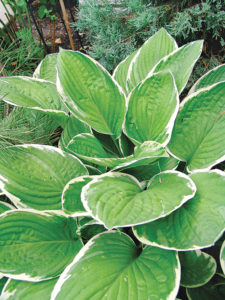 Virtually ignored 40 years ago hostas are now one of the most commonly sought after garden plants. Mostly due to their easy growing nature. Lush, leafy mounds grow in three to four foot clumps. They sprout stalks of purple, mauve, white or blue richly scented flowers in late summer. Hostas, also known as plantain lily, are available in an ever increasing number of cultivars sporting green, blue-green, marbled and marginated leaves. Tolerant to zone two, they thrive in partial to full-shade and acclimate well in moist well-drained soil. Hostas provide wonderful lush ground covers and their shallow root system allow them to be planted in a wide range of areas. A favourite shade perennial, these hardy beautiful plants deserve a spot in every garden. |
For beauty: Bleeding Heart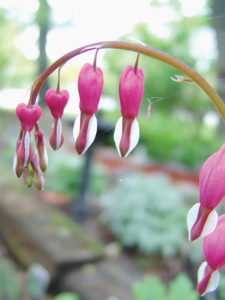 The delicate heart-shaped flowers of this plant hang from gracefully arching stems, blooming early in spring and sporadically throughout the summer. Flowers come in various colour combinations of yellow, pink, red and white. Easy to grow this hardy herbaceous perennial will thrive in various conditions but prefers cool, moist locations with partial shade, making it ideal for woodland gardens. While they are prolific self seeders, they may also be divided every couple of years in the spring or fall. Cuttings from large plants or young shoots can also be used for propagation in the spring. Bleeding hearts need to be cut back in the fall or late summer once the plant has fully died back. They enjoy compost and time released plant food will increase bloom yields. This deer resistant beauty is hardy to zone two and will grow to a height of one to three feet with a similar spread depending on the variety purchased. Bleeding hearts have been a classic garden perennial for over a century and are still an elegant addition to any garden. |
For drama: Peony These massive eye catching flowers are a show-stopper for any garden. Peonies are beloved for their hardy nature, low maintenance and beautiful blooms. Available in a wide range of colours from bright whites to deep vibrant hues and multi-coloured configurations, plants can also be selected by bloom size: single, semi-double, double, anemone or Japanese varieties. Peonies grow in three-foot-tall by three-foot-wide herbaceous shrubs that droop when laden with flowers and die back in the fall; unless you own a woody variety. Staking plants with rings will keep them looking neat and tidy in the garden. The heavily scented flowers bloom from late May to the end of June for a period of four to eight weeks. These garden standbys prefer well-drained, moist soil – not wet, and can be fed lightly with a balanced perennial formula. They tolerate both drought and deer and can live for up to 50 years! Once established, just leave these beauties alone. |
For climbing: Clematis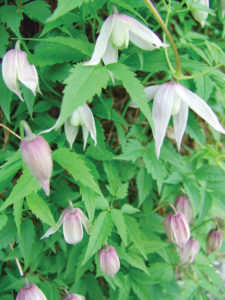 These trailing beauties will light up any fence, trellis or wall. Clematis is one of the most popular perennial flowering vines. Available in almost every colour, single, double or semi-double blooms of various sizes, there’s bound to be a clematis you will fall in love with. They prefer fertile, well-drained soil and appreciate a regular fertilization routine. And, while they adore sunny locations, preferably with morning light, clematis does not tolerate excessive heat. It is important to water their roots regularly and keep them cool with shade from nearby perennials or mulch. Bloom time depends on the variety purchased. Clematis requires support for climbing, which they do by twining their slender stems around wires or other thin supports, they can even be trained to grow on trees. The vines are organized into one of three groups based on blooming habits. The first group blooms on last year’s wood in early spring. This is the best time to prune dead branches. Flower groups that bloom on new growth in May, June or July form the second group and the third bloom from July until fall. Clematis that bloom on new wood do require regular pruning; after the first year they will need to be cut back to ground level and then back to six inches above the base of the previous year’s growth in subsequent years. A stunning and exotic-looking vine that will add character to any garden up to zone three, this is a must have perennial. |
For butterflies: Milkweed Bright, beautiful and the lifeblood of the monarch butterfly, can you afford not to have this plant? Native to North America, milkweed boasts bright pink, orange, yellow or white flowers from early summer to early fall and can grow up to one metre high. Also known as butterfly weed non-invasive varieties such as Asclepias tuberosa or Asclepias incarnata have been bred. They produce large amounts of sweet nectar with a heady vanilla scent to attract butterflies, hummingbirds, bees and other insects. They are an excellent addition to borders, wildflower gardens and mass plantings. Milkweed prefers full sun and dry to medium well-drained soil and is very tolerant to dry conditions due to its deep taproot. Plants will self seed but do not take well to being transplanted. Overuse of herbicides has decimated many wild crops of A. Syriaca, an invasive but necessary perennial. Milkweed is the only plant that the monarch butterfly will lay eggs on and on which the caterpillars will feed. Milkweed not only looks beautiful but will help to increase our dwindling numbers of monarch butterflies. |
For Rock Gardens: Hens and Chicks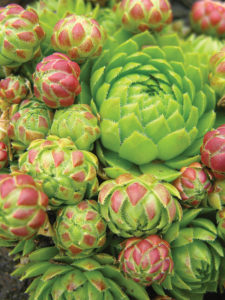 An often overlooked but adorable perennial perfect for areas that are uninhabitable for most other plants. Its Latin name, sempervivum, means “live forever” as they grow rapidly and propagate easily; however, the actual plant is a short-lived perennial which only survives for three years. It is due to their massive production of offspring that they appear long-lived. These are excellent plants for new gardeners and children, ideal for containers, houseplants and ground cover. Sempervivum are succulents and therefore require lots of light, low water and little soil. They will grow in rock cracks and on gravel. There are over 3,000 cultivars to choose from in shades of bright red, grey, purple or green, as well as bearded varieties with hairs or web-like coverings. Hens, the mother plant, produce “chicks” on runners which can be pulled off and replanted or left to grow around the mother. |




